- Open-source platforms come with zero licensing fees, and they are fully customizable.
- TWhat is a CDP?
- WooCommerce or PrestaShop are great options for small and medium-sized stores.
- Magento is good for enterprise-level stores but requires huge technical resources.
- Bagisto and Spree are more modern options, designed for developer-centric, headless commerce.
- If you want a 100%-managed solution, don’t use open-source.
The world of eCommerce is now more mature, but there is still one variable dependent on your choice of platform: how much control, flexibility, and scalability you have to build, grow, and customize your online business. Open-source eCommerce platforms continue to rise above many of the paid SaaS and subscription-based options available today because they give you complete control, no licensing costs, and unlimited flexibility.
In 2025, businesses are increasingly selecting open-source solutions for not only the economic benefits but also the long-term scalability, customization capabilities, and control over front and back-end logic. This is still a practical option for developers and business owners who want to be at the wheel.
Having said that, the reality is, open-source also presents its challenges. It is not without responsibility; it entails more technical aptitude and may present a steeper learning curve. So, here, in this blog, we are going to share the best open-source eCommerce platforms available, along with their benefits, disadvantages, and what you will be committing to if you choose one over the other.
What Is an Open-Source Ecommerce Platform?
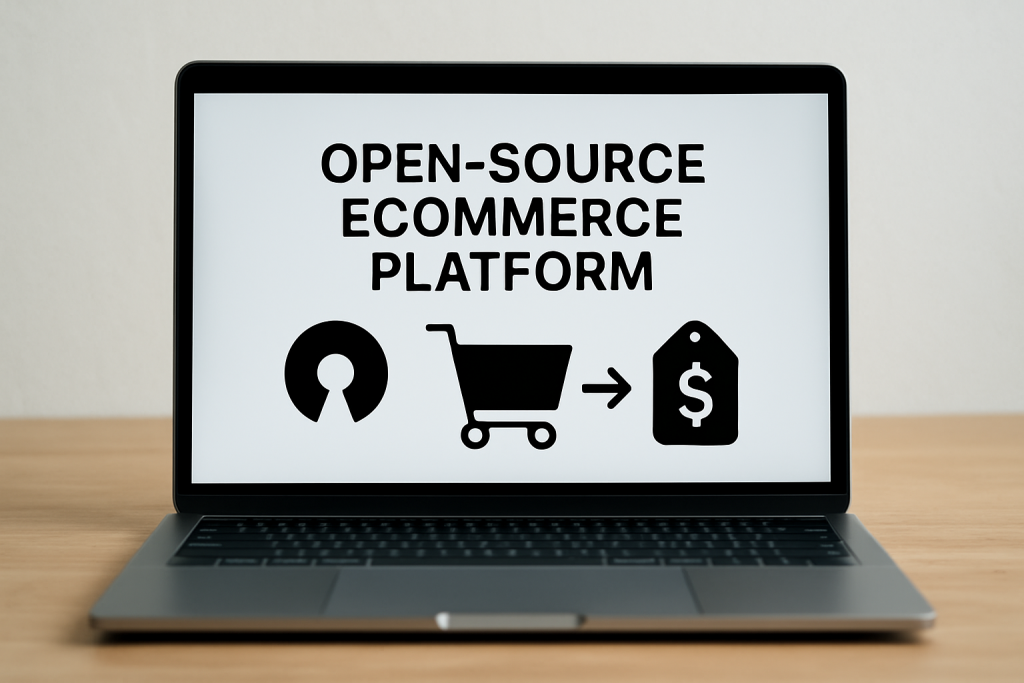
An open-source eCommerce platform is software that is freely available to download, modify, and use to create and run your online store. You don’t have a monthly plan limiting your functionality or access; you own the installation and the code with all the associated infrastructure.
Open-source platforms do not lock you into using specific hosts. This means you do not have any limitations or restrictions on backend capabilities. Being self-hosted in nature, these platforms make it immensely easy for you to set them up on a web server and handle your own updates, security patches, and scale infrastructure based on your traffic. With open-source, you have total freedom to build what you need without friction – no compromises, no vendor policy, and no paywalls on vital features.
These platforms are generally free-standing and are backed by huge developer communities supporting plugins, extensions, and themes to help businesses dial in their online stores to the last pixel.
Pros and Cons of Open-Source Ecommerce Platforms
When selecting open-source software instead of a fully hosted solution, you’re making more than a technology choice; you’re making a strategic move. Below are the benefits and risks:
Benefits of Open-Source Ecommerce Platforms
1. No Licensing Fees
The most significant advantage is monetary. You do not have to pay a licensing fee or a monthly subscription simply to have access to the platform itself. This is preferable for startups, small businesses, or anyone using a tight operating budget. You will still have hosting costs, and possibly even development costs or expenses for premium plugins, but the core platform is free.
2. Complete Customizability and Flexibility
You have the level of control you need over everything – design, functionality, integrations, and even checkout flow. If you have access to skilled development resources, your store can do literally anything. Do you want to build a headless storefront? Integrate with a custom ERP? Rewrite the product catalog module? You can!
3. Complete Data Ownership
With open-source platforms, the data for your store is generally stored on your own servers. That means you are not relying on a third-party platform to control your customer information, order history, or sales analytics. This can be especially valuable to businesses that have a strong ethics or compliance bias toward customer privacy.
4. Large Community of Support
Open-source eCommerce ecosystems are normally supported by forums and large communities of thousands of developers and contributors, providing free extensions, fixes, and updates. Some platforms even have marketplaces dedicated to free and paid plugins, with hundreds of add-ons available that can greatly extend your store’s functionality.
5. Much Easier Long-Term Scalability
Because there is no feature-oriented pricing tier with open-source, your costs will not increase based on your revenue or number of products. You’re free and clear to scale your store from a few dozen products to a few thousand products without paying more in costs to do so! With the right setup and optimizations, open-source platforms will scale very well.
Downsides of Open-Source Ecommerce Platforms
1. Steeper Learning Curve
These platforms are not necessarily for novices and beginners. The setup process can be quite jarring for individuals who are new to hosting, FTP, or PHP configurations. Some platforms do have one-click installers or managed hosting partners, but setting up a production-level open-source store will take time and technical proficiency, no matter what.
2. You are Responsible for Hosting and Maintenance
With great power comes great responsibility. You need to pay for hosting and manage it while also taking care of expenses for developers, security setups, and ongoing software updates. If you are not careful, bad maintenance can lead to product and speed issues or potential security issues.
3. Development Costs Can Add Up
In spite of the fact that open-source software comes free of cost, you will most likely need a developer’s help to add advanced features, or even just implement customizations. You may also need to pay for premium plugins, custom themes, and performance tools. Over time, these costs can add up, even more so if you are quickly scaling or working on multiple storefronts at once.
4. Possible quality issues
There are endless extensions and themes out there in the open-source world provided by other developers. Not all extensions work together perfectly. Apps (or extensions) may stop working when they are updated, and may also introduce bugs that will need to be resolved. You will need to have a testing environment and a staging environment established if you want to customize open-source software, particularly if you’re dealing with a large-scale setup.
5. No Official Support
While the SaaS platforms offer the option to get help via live chat and dedicated support channels, you have to rely on community forums, GitHub issues, and freelance experts when working with an open-source platform. If something breaks, you are basically out of luck, unless you’ve hired an agency or freelancer to offer you support.
Top Open-Source Ecommerce Platforms You Can Use for Free in 2025
So, without further ado, let’s jump into the top open-source eCommerce platforms you can use for free. These platforms have their own benefits and drawbacks, which have been explained to ensure that you can make the right decision. While choosing one over the other, make sure that you are considering every aspect, from ease of use to scalability, and ongoing maintenance.
WooCommerce
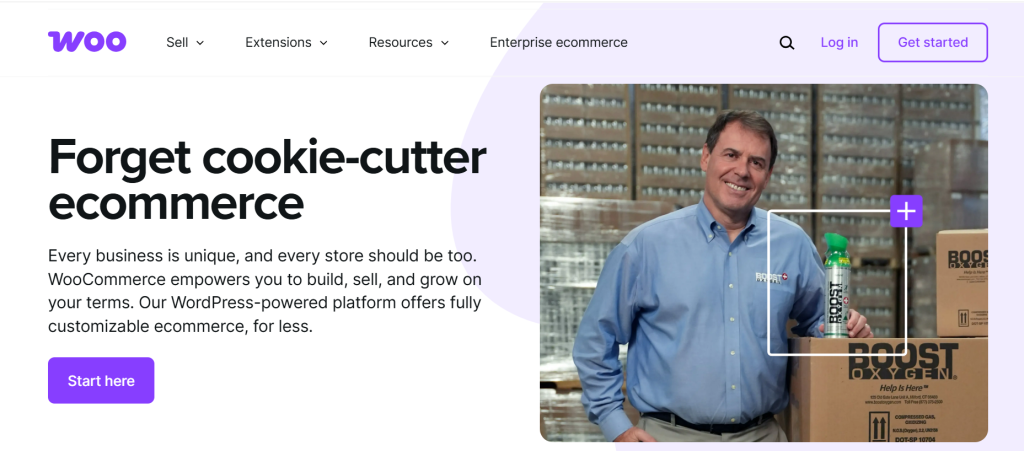
WooCommerce is a flexible, free plugin that will give a full-fledged eCommerce solution to any WordPress website. It’s best suited to individuals already familiar with WordPress, as everything integrates nicely with blogs, landing pages, and SEO functionalities. The initial setup is relatively easy for beginners, and there is a huge library of thousands of plugins and themes, allowing for relatively easy configuration and customization without being a coding ninja.
It can handle physical and digital products, payment gateways, shipping options, and a wide array of marketing and analytics configurations. You also have access to REST APIs, in case you want to set up a headless commerce installation.
Pros
- Easy to set up for WordPress users
- Massive ecosystem of plugins and themes
- Great for SEO and content-first stores
- No licensing fees
- Flexible as stores grow in size
Cons
- Relies heavily on plugins to add advanced features
- May slow down with lots of additional plugins
- You need to monitor performance and technical issues as you scale
- Not suited for complex multi-vendor or enterprise stores without extensive customization
Magento Open Source

Magento Open Source is a powerful, developer-oriented platform with scalability and flexibility. Magento provides a more advanced solution compared to a lighter setup like WooCommerce! While WooCommerce is better for smaller businesses or content-led stores, Magento, on the other hand, is a great pick for medium to large-scale businesses, managing a complex catalog! Magento offers exceptional value for global operations and complex customizations.
Magento Open Source has powerful built-in features, including multi-store capabilities, customer segments, pricing rules, layered navigation, and support for multiple languages and currencies, among many others. It also has a vast community of developers and extension providers.
But it’s not all sunshine and rainbows – the platform comes with a fair amount of technical complexity. Compared to a lighter platform, Magento has more technical requirements and thus, a considerable learning curve. Setup, maintenance, and optimization generally require a dedicated developer or a team. Hosting and server requirements also require excessive capacity consumption.
Pros
- Very scalable and flexible
- Built-in advanced eCommerce features
- Good for multi-store, multi-language, and multi-currency features
- Strong developer community support around the world
Cons
- Technically difficult to manage without a developer
- Hosting and optimization are costly
- Even moderate changes require a considerable investment of time and money
- An overkill for small businesses or new sellers.
PrestaShop
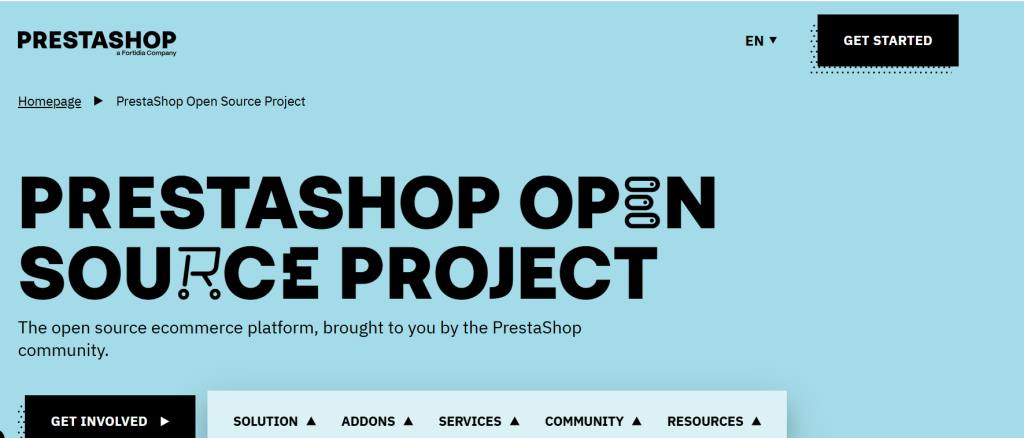
If you’re a merchant in need of an open-source eCommerce platform, PrestaShop is a great choice, offering lots of features and a powerful online store with very little coding. PrestaShop strikes a good balance between ease of use and flexibility, making it perfect for small to medium-sized businesses that can grow without a lot of technical knowledge.
PrestaShop has strong built-in capabilities like customizable product pages, built-in tax and shipping management, international features (multi-language and multi-currency), and a backend that is fairly intuitive. As an added bonus, PrestaShop has a pretty big add-on marketplace with both free and paid modules to enhance the functionality of your store even more.
Installing your store is straightforward using PrestaShop’s cloud hosting partner or a shared host run by a recognized partner, but you’ll probably want to get help from a developer if you have more complex needs.
Pros
- Easy-to-use admin panel
- Amazing support for international stores
- A large module and theme market
- Active community for support and upgrades
Cons
- Key features are only available for paid add-ons
- Can become bloated with too many module installations
- Needs regular and timely updates as well as occasional developer involvement
- All add-on modules across the marketplace aren’t of high quality.
OpenCart
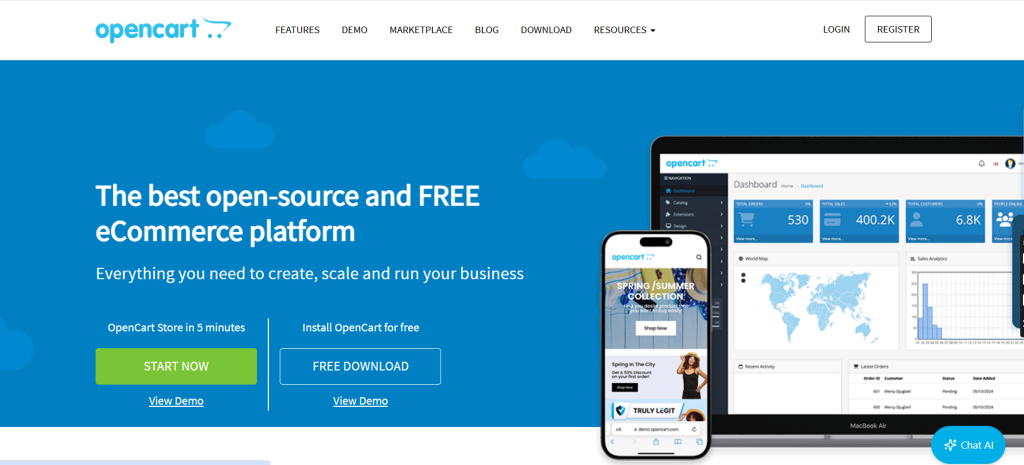
OpenCart is a lightweight, open-source eCommerce platform that is easy, fast, and simple to use. It is a good choice for merchants who want to get to market quickly via the simplest learning curve and least effort.
OpenCart features a fairly comprehensive set of core eCommerce functionalities like product management, multi-store functionality, discount systems, recurring payments, and multi-language and multi-currency capabilities. And the best part is, even the non-coders and beginners can use its admin panel with ease, thanks to the plain admin panel.
While OpenCart is a lighter option than platforms like Magento Open Source, it also comes with less flexibility. It does not support many of the advanced customizations you get with many other platforms. The options are typically provided by third-party extensions, and if you have a larger store, you may find the architecture restrictive.
Pros
- Lightweight and easy to launch
- Clean Admin Panel suitable for beginners
- Built-in multi-store and language support
- Low server requirements and fair performance
Cons
- Very reliant on third-party extensions for advanced features
- Limited scalability for complex or larger stores
- Mis-matches and conflicts are common with extensions
- Not the best option for highly customized storefronts without custom coding
Bagisto
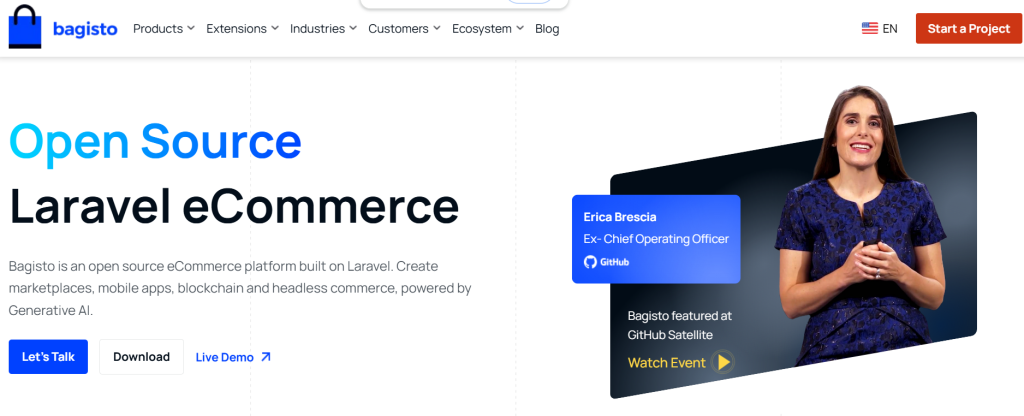
Built on Laravel, Bagisto has become a go-to eCommerce platform for various businesses. Despite being new to the market, Bagisto is gaining a lot of traction owing to its open-source nature and its foundation being built on one of the most renowned PHP frameworks. Businesses and startups looking to develop a modular, modern, scalable, and customized solution from scratch that’s also developer-friendly can pick Bagisto.
The built-in advanced features such as highly advanced inventory management, RTL support, multi-vendor marketplaces, localization, and headless commerce support. Thanks to the clean and clutter-free Laravel codebase along with an intuitive and straightforward dashboard, it has quickly become a developer favorite.
Since the platform is still new and growing, you won’t find as many plugins and add-ons as you can with Magento or WooCommerce, but it’s worth trying if you want a modern, API-driven eCommerce foundation.
Pros
- Built on Laravel, developers can quickly customize the solution
- Native multi-vendor and multi-inventory options support
- Progressive web app (PWA) and headless commerce come built-in
- Strong for international/local stores
Cons
- Smaller community and extension marketplace (for now)
- Less plug-and-play for newcomers
- Requires developer assistance for setup and scale
- May not have certain robust integrations without custom work
Spree Commerce
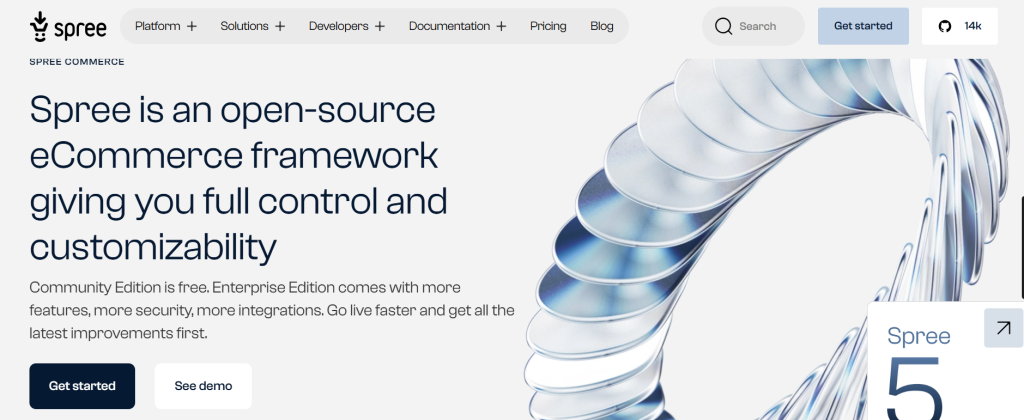
Spree Commerce is a fast, headless, open-source eCommerce platform built on Ruby on Rails. It’s a platform tailored towards businesses that prefer to have full control over their front-end and backend, making it ideal for developers looking to build custom commerce experiences, in-app purchases, or other multi-channel storefronts.
As a headless-first platform, Spree differs from traditional monolithic platforms, as its headless architecture separates the frontend from the backend, and allows businesses to serve customers across multiple channels (web, mobile, kiosk, IoT, etc.) using the same backend. It is designed to be as performant as possible and is highly extensible due to its modular nature & REST API.
While Spree is not the easiest platform for a beginner to adopt and has a limited plugin marketplace, it offers the speed, freedom, and architectural flexibility that should appeal to developer teams, especially tech-led teams, or SaaS-based businesses focused on building tailored commerce solutions.
Pros
- Headless-first and API-first, ready to support modern commerce setups
- Lightweight, fast, and extremely scalable
- Completely modular codebase allowing for full customization
- Perfect for mobile, app-based, or B2B commerce
Cons
- Requires knowledge of Ruby on Rails
- Not recommended for users who are non-technical
- Limited plugin/theme ecosystem
- The community is much smaller than PHP-based platforms
How to Choose the Right Open-Source eCommerce Platform
Choosing the right free platform can be a difficult task, as there are various exceptional options out there. When it comes to picking the best open-source ecommerce platform for your situation, it mainly is a matter of what you need, available resources, and long-term vision.
1. Technical Expertise
If you don’t have technical expertise or a tech team at your disposal, platforms like WooCommerce or PrestaShop are easier options for you to manage and run your store. On the other hand, platforms like Magento, Spree, and Bagisto will require developer resources from the initial setup to help you scale beyond a simple install. These platforms have a level of complexity that will require continuous maintenance as well.
2. Business Size and Complexity
If you have a small boutique store, you probably don’t need the power or headache of Magento. On the other hand, if you have a business that requires multi-warehouse inventory, multiple international storefronts, or an enterprise solution, then simpler platforms may not meet your business requirements.
3. Level of Customization
Are you looking to build a headless solution? Do you need a PWA or a multi-vendor marketplace? Bagisto and Spree will handle all of that and more. When it comes to the likes of WooCommerce and OpenCart, they can accommodate a moderate level of customization, but they will start to struggle when you require unique logic without relying on all of those plugins to do all of your heavy lifting.
4. Scalability
Lastly, you should be looking into the future. A good platform should grow with your business as you envision it. Platforms like Magento and Bagisto scale effectively. While OpenCart and PrestaShop also scale nicely, you may just hit a growth wall soon with performance and limitations.
5. Community and Ecosystem
An engaging and active community can really make or break your experience. WooCommerce and Magento have massive communities of developers and large extension marketplaces. Newer platforms like Bagisto are still left behind, but they are also quickly establishing strong communities.
When NOT to Choose an Open-Source Ecommerce Platform
Despite everything, the truth is, that open-source eCommerce platforms are not for everyone. Open-source sounds great (hey, free software!), but it does come with a string of trade-offs:
- You Need Zero Maintenance: Open-source platforms tend to need updates, security patches, and some hosting/maintenance management. If you are looking for zero maintenance on your eCommerce site, consider SaaS instead.
- You Have No Developer Access: Most open-source solutions are developer-heavy. It will be highly frustrating (if not impossible) to manage Magento, Spree, and Bagisto if you don’t have access to a tech team.
- You Want Enterprise-Level support: Open Source means you will not have any official support. Instead of the 24/7 support SaaS platforms offer, you are only left with hours of scrolling through online communities and contacting freelancers to fix your issue.
- You Want Faster Time to Market: SaaS (like Shopify or BigCommerce) often offers a much faster time to market with far fewer decisions and no headaches!
Final Thoughts
In 2025, the open-source eCommerce ecosystem has become immensely powerful. Whether you’re pursuing a passion project or looking to migrate from a bloated SaaS platform, there is a free and flexible option out there to fit your business — no licensing fees, no vendor lock-in, and complete control of your store.
Here is a quick summary of which platform is best suited for:
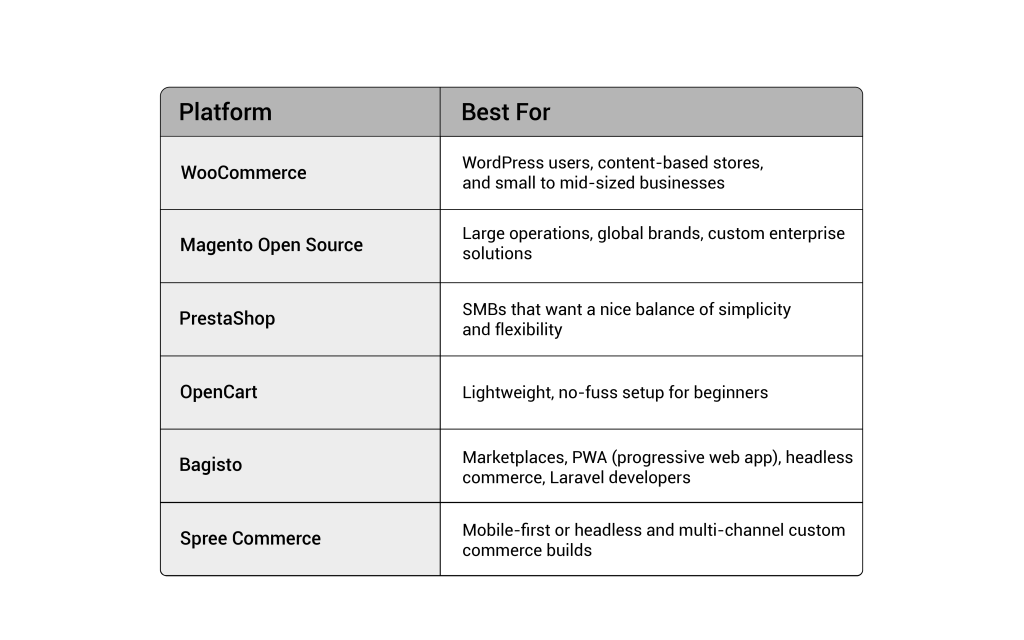
FAQs
Yes, WooCommerce can certainly run larger stores, but it does come down to having good hosting, optimizations, and caching systems in place. It’s not very good for extremely large catalogs without proper infrastructure.
OpenCart is one of the best platforms in the market in terms of ease of use. Not only does it offer a clean admin panel, but it’s also easy to set up and has built-in eCommerce features you can leverage without having pro-level technical expertise.
Yes. Magento requires a good technical background to set up and scale the store, as well as maintain the security and customization of the site. If you don’t have a good amount of technical expertise and experience, it is not recommended.
With open-source, you get full access to the code and full control over your store minus any monthly subscription that comes with SaaS. However, you are responsible for everything – hosting, maintenance, security, etc. SaaS gives you a great deal of ease and support with a managed solution, but you have less control over the platform.
Yes!. Platforms like Bagisto and Spree Commerce are built around headless setups and have the proper support out of the box, such as APIs and PWA support. Magento and WooCommerce both allow for custom headless setups.









